S1N reaction on optically active substrates mainly gives:Solution in Odia
Retention in configuration
Inversion in configuration
Racemic product
No product
The correct Answer is:C
Step by step video, text & image solution for S_N^1 reaction on optically active substrates mainly gives: by Chemistry experts to help you in doubts & scoring excellent marks in Class 12 exams.
Updated on:21/07/2023Topper's Solved these Questions
Similar Questions
Name an isotope of hydrogen.
View SolutionOn completing combustion, 0.246 g of an organic compound gave 0.198 g of carbon dioxide and 0.1014 g of water. Determine the percentage composition of carbon and hydrogen in the compound.
View SolutionNucleophilic aliphatic substitution reaction is mainly of two types: S_(N)1 and S_(N)2 . The S_(N)1 mechanism is a two step process. Reaction velocity of S_(N)1 reaction depends only on the concentration of the substrate. Since product formation takes place by the formation of carbocation, optically active substrate gives (+) and (-) forms of the product. In most of the cases the product usually consits of 5-20% inverted product and 80-95% racemised species. The more stable the carbocation, the greater is the proportion of racemisation. In solvolysis reaction, the more nucleophilic the solvent, the greater is the proportion of inversion. For the gives reaction, Which substrate will give maximum racemisation?
View Solutionप्रकाशीय श्वसन का अवस्तर (सब्स्ट्रेट) है।
View SolutionIf alkyl halide is optically active SN1 reaction leads to,
View SolutionS_(N)1 reactions are accompanied by racemization in optically active halides.
View SolutionNumber of optically active compounds out of following that can give Haloform reactions.

View SolutionS1N reaction is favoured by
View SolutionGive reasons : S_(N)1 reactions are accompanied by recemisation in optically active alkyl halides.
View SolutionSN^1 reaction are accompanied by racemisation in optically active alkyl halide. Explain.
View SolutionNucleophilic substitution reactions are of two type - S1N reaction and S2N reaction. Write any two differences between S1N and S2N reactions
View SolutionS_N^1 reaction takes placed in two steps. The relative reactivity of an alkyl halide in S_N^1 reaction depends on the relative stability of carbocations formed by ionisation. What will happen to the optical activity of a dextro rotatory isomer of alkyl halide if it undergoes hydrolysis by S_N^1 mechanism ?
View SolutionWhich one will give faster S_N^1 reaction:
View SolutionWhat is the optical nature of the product obtained in an SN1 reaction if the substrate is optically active ?
View SolutionAmong the given halides, which will give same product in both S_N 1 and S_N 2 reactions(excluding stereoisomers)?
View SolutionNumber of optically active compounds out of following that can give Haloform reactions.
View Solution
